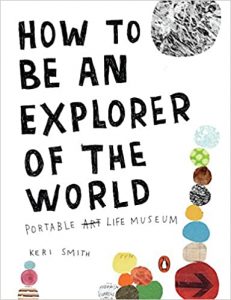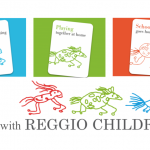How To Be An Explorer Of The World
Teachers are artists. Now, more than ever, we see our collective artistry at work as we re-create virtual learning spaces and continue to engage our students in meaningful ways. I am reminded of one of my favourite books, How to be an Explorer of the world by Canadian author Kerri Smith. Through her series of beautifully hand-illustrated interactive  prompts (or explorations), she encourages us to explore and discover the world in ways we never imagined – just as we are today. Her books are about daring yourself in small ways on a regular basis and leaning into the mess of uncertainty in order to build a habit and create openings for new thinking.
prompts (or explorations), she encourages us to explore and discover the world in ways we never imagined – just as we are today. Her books are about daring yourself in small ways on a regular basis and leaning into the mess of uncertainty in order to build a habit and create openings for new thinking.
Those of us who have taught Kindergarten, recognize that time for Exploration is at the heart of our work. These classrooms have always been driven by the spirit of experimentation and discovery. Here, we invite children to be “Explorers of the world” as they play with ideas, materials and each other. With this same playful spirit, we intentionally create opportunities and contexts that invite them to explore their identities as storytellers, artists, musicians, mathematicians and scientists (to name a few) while we explore our own roles as responsive educators. As children create their own “play scripts” during Explorations, so too are we now artfully creating new “scripts” for teaching remotely. Whether we are exploring new technologies or figuring out authentic ways to give voice to children’s thinking online, we are all leaning in and taking on new challenges just as we would encourage our students to do.
So, as I lean in to the “creative mess” that is my ever evolving blog and take up the challenge to be “an explorer of the world” of technology, I am reminded that all of our creative skills are needed to keep up this meaningful work and that these other ways of being together will survive well past this time. Could this enhanced creative spirit be the silver lining?
This week’s Blog Highlights: (Note: I’ve almost settled on a framework that makes sense…at the moment. Don’t be surprised if my “widgets wander” and a new aesthetic appears!
The thing that excites me the most about bookmaking is how quickly ALL children see themselves as writers and builds their identity as creators of all kinds of texts. As a big fan of Matt Glover and an advocate for nurturing our earliest writers, I invite you and your families to watch his series of videos in which he shares the importance of bookmaking. These videos help parents to understand how to support children’s writing and demystifies issues around spelling. He has many more videos and will be adding to this series regularly.
Ask children to use whatever paper is available and encourage them to choose a variety of mark-making materials. If they are without a stapler, go to “How to make a book without staples” at Fold Something (I love this site for other paper creations, too). I would also invite you to create a simple book yourself and share it with your students. Whether its a “How to…” book or a story about your dog, children benefit from reminders that writers need an audience and that our writing identities come from the stories we tell each other.
If you are interested in learning more about the pedagogy of bookmaking and how we can “back map” the learning to our K-3 Language Arts Big Ideas and curricular competencies, please let me know.
@Home with the Reggio Approach
As always, these creative, cross-curricular ideas offered by Reggio Children are inspiring and engaging for all. I highly recommend listening to the story of The Concert and think about incorporating your own weekly Sound Riddles. This site is updated regularly, too.


Leave a Reply